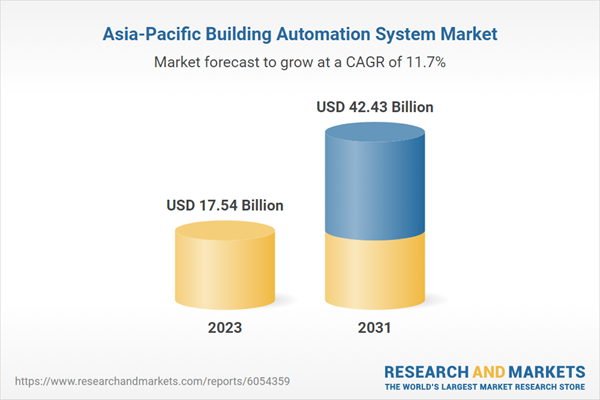Growing Need for Sustainable Building Automation Solutions Boosts Asia Pacific Building Automation System Market
Sustainable buildings aim to minimize energy consumption and carbon emissions. BAS can monitor, control, and optimize HVAC, lighting, and other systems based on occupancy and environmental conditions. With an increasing shift toward renewable energy sources, such as solar and wind, BAS can intelligently manage the integration and utilization of these sources within building operations, ensuring optimal energy use and substantial cost savings. BAS provides real-time data on energy usage and environmental metrics, facilitating informed decision-making for energy conservation strategies and compliance with sustainability standards and regulations. Sustainable buildings prioritize occupant comfort and health. BAS can maintain indoor air quality, regulate temperature, and optimize natural lighting, contributing to enhanced occupant satisfaction and productivity. Also, sustainable BAS solutions result in cost savings due to reduced energy expenses, lower maintenance needs, and prolonged equipment life, making them financially attractive for building owners and operators. The use of sustainable solutions aligns with global sustainability goals, improving energy efficiency, enhancing occupant comfort, and offering significant economic benefits for building owners and operators. Thus, the growing need for sustainable building automation solutions across industries is expected to create significant opportunities for the building automation market growth during the forecast period.Asia Pacific Building Automation System Market Overview
In August 2022, Johnson Controls, a renowned global leader in intelligent, sustainable, and health-focused buildings, collaborated with Microsoft Beijing Campus to continually renovate and enhance building operations. This strategic alliance has yielded remarkable results, including a 27.9% reduction in energy consumption and a 98% uptime for critical equipment. Consequently, the campus has received recognition for energy conservation and financial support from the Beijing Municipal Government and the Haidian District Government. This initiative aligns with China's commitment to peak carbon emissions by 2030 and achieve carbon neutrality by 2060, placing significant emphasis on the building sector to embrace the latest sustainable engineering technology. This partnership serves as a prime example of how AI and advanced building automation systems can significantly enhance energy efficiency and operational automation in large-scale building operations. Microsoft Beijing Campus also utilizes Johnson Controls Metasys Building Automation System (BAS) to monitor cooling and heating equipment, channeling significant data into OBEM for analysis. Such collaboration initiatives drive the Asia Pacific building automation system market.Asia Pacific Building Automation System Market Revenue and Forecast to 2031 (US$ Million)
Asia Pacific Building Automation System Market Segmentation
The Asia Pacific building automation system market is categorized into component, end user, and country.Based on component, the Asia Pacific building automation system market is bifurcated into hardware and software & services. The hardware segment held a larger market share in 2023. Furthermore, the hardware segment is sub segmented into security & surveillance system, facility management systems, fire protection systems, and others.
In terms of end user, the Asia Pacific building automation system market is segmented into commercial, industrial, and residential. The commercial segment held the largest market share in 2023.
By country, the Asia Pacific building automation system market is segmented into Australia, China, India, Japan, South Korea, and the Rest of Asia Pacific. China dominated the Asia Pacific building automation system market share in 2023.
ABB Ltd; Mitsubishi Electric Corp; Bosch Sicherheitssysteme GmbH; Honeywell international Inc; Schneider Electric SE; Siemens AG; Johnson Controls International Plc; Carrier Global Corp; Lutron Electronics Co., Inc; and Trane Technologies Plc are some of the leading companies operating in the Asia Pacific building automation system market.
Reasons to Buy
- Save and reduce time carrying out entry-level research by identifying the growth, size, leading players, and segments in the Asia Pacific building automation system market.
- Highlights key business priorities to assist companies to realign their business strategies.
- The key findings and recommendations highlight crucial progressive industry trends in the Asia Pacific building automation system market, thereby allowing players across the value chain to develop effective long-term strategies.
- Develop/modify business expansion plans by using substantial growth offering developed and emerging markets.
- Scrutinize in-depth Asia Pacific market trends and outlook coupled with the factors driving the Asia Pacific building automation system market, as well as those hindering it.
- Enhance the decision-making process by understanding the strategies that underpin commercial interest with respect to client products, segmentation, pricing, and distribution.
Table of Contents
Companies Mentioned
- ABB Ltd
- Mitsubishi Electric Corp
- Bosch Sicherheitssysteme GmbH
- Honeywell international Inc
- Schneider Electric SE
- Siemens AG
- Johnson Controls International Plc
- Carrier Global Corp
- Lutron Electronics Co., Inc
- Trane Technologies Plc
Table Information
| Report Attribute | Details |
|---|---|
| No. of Pages | 148 |
| Published | January 2025 |
| Forecast Period | 2023 - 2031 |
| Estimated Market Value ( USD | $ 17.54 Billion |
| Forecasted Market Value ( USD | $ 42.43 Billion |
| Compound Annual Growth Rate | 11.7% |
| Regions Covered | Asia Pacific |
| No. of Companies Mentioned | 10 |









